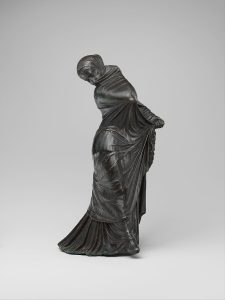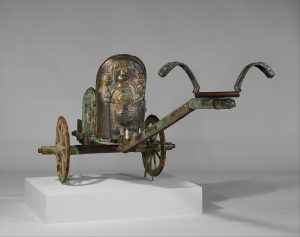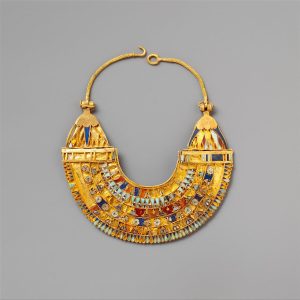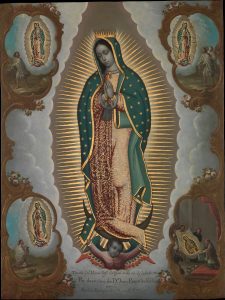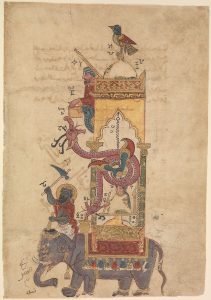13 Chapter 13: Art for you!
Maria Americo
Chapter 13: Art for you!
In this chapter, our last chapter together, it’ll be your turn. You’re invited now to take everything we’ve learned and begin to create “questions for reflection” on some art pieces for yourself.
For each piece of art, you will find the image source, as always, plus some further reading. But it’ll be up to you to create some questions to help guide you through seeing and understanding the art. For your reference, and for some inspiration as to the kinds of things you can notice and ask questions about when looking at a piece of art, here are some elements you might observe when encountering art. We first saw this list in chapter 3 of this textbook.
9 things to observe when looking at a piece of art
1) What colors are used in the piece? What is the main color? What mood or tone do the colors convey? How did the artist create that color?
2) What figures, animals, aspects of the natural world, objects, shapes, etc. are present within the art?
3) Story and narrative. What story is being told through the art? What happened before the scene on the art; what will happen after? Does the artist assume the audience already knows this story, or are they telling it for the first time? Can we recognize the historical time period or historical events in this art?
4) Human interactions and relationships. If there are people featured in this art—how are they dressed? How are they moving through the space? How are they interacting with other people / animals / nature / objects? Can you tell what kind of people they are? Can you tell how they feel about themselves, others, or their situation?
5) Chronology and geography. Do any details of the art give you a sense of where, or when, it was made?
6) Function and use. How was this piece of art (or object) used? How can you tell? Why was it created? If you had this object, what would you use it for?
7) Condition and preservation. What is the condition of this piece of art? Does its condition reveal anything about where it was found (archaeologically) or how it was preserved since it was made?
8) Shape and material. What is the shape of this art or object? How do its decorations, imagery, or scenes interact with its shape? What is the object made of? How does its material interact with its decoration, form, or use?
9) Mood and emotional resonance. What mood or vibe does this art evoke? How do you think its creator wanted to make people feel when they saw it? How do you feel, looking at this art? What does it remind you of?
Bronze statuette of a dancer
Greek
3rd-2nd century BCE
-Image by the Metropolitan Museum of Art, used under a Creative Commons Zero (CC0) license, Public Domain
-Learn more about this art and find the image source here.
Further reading for this art here: Pergamon and the Hellenistic Kingdoms of the Ancient World: Three Centuries of Greek Art from Alexander the Great to Cleopatra – The Metropolitan Museum of Art
Make up some questions about this art piece for yourself!
Bronze chariot inlaid with ivory
Etruscan
6th century BCE
-Image by the Metropolitan Museum of Art, used under a Creative Commons Zero (CC0) license, Public Domain
-Find the image source and learn more about this art here.
Further reading for this art here: Connections: Reverence – The Metropolitan Museum of Art ; Credo Reference – Etruscans
Make up some questions for this art piece for yourself!
Broad collar necklace
Egypt
332–246 BCE
-Image by the Metropolitan Museum of Art, used under a Creative Commons Zero (CC0) license, Public Domain
-Learn more about this art and find the image source here.
Further reading for this art here: Turquoise, Trade, and Statuary in Ancient Egypt – The Metropolitan Museum of Art
Make up some questions for this art piece for yourself!
The Virgin of Guadalupe with the Four Apparitions
Mexico
1773
-Image by the Metropolitan Museum of Art, used under a Creative Commons Zero (CC0) license, Public Domain
-Learn more about this art and find the image source here.
Further reading for this art here: Mexico and Central America, 1600–1800 A.D. | Chronology | Heilbrunn Timeline of Art History | The Metropolitan Museum of Art
Make up some questions for this art piece for yourself!
“The Elephant Clock,” folio from a manuscript of the Book of the Knowledge of Ingenious Mechanical Devices
Iran
dated 715 AH/1315 CE
-Image by the Metropolitan Museum of Art, used under a Creative Commons Zero (CC0) license, Public Domain
-Learn more about this art and find the image source here.
Further reading for this art here: The Art of the Mamluk Period (1250–1517) – The Metropolitan Museum of Art ; The Eastern Mediterranean, 1000–1400 A.D. | Chronology | Heilbrunn Timeline of Art History | The Metropolitan Museum of Art
Make up some questions for this art piece for yourself!
Media Attributions
- Greek dancer statue
- Etruscan chariot
- Egyptian necklace
- La Virgen de Guadalupe
- Elephant Clock manuscript folio
